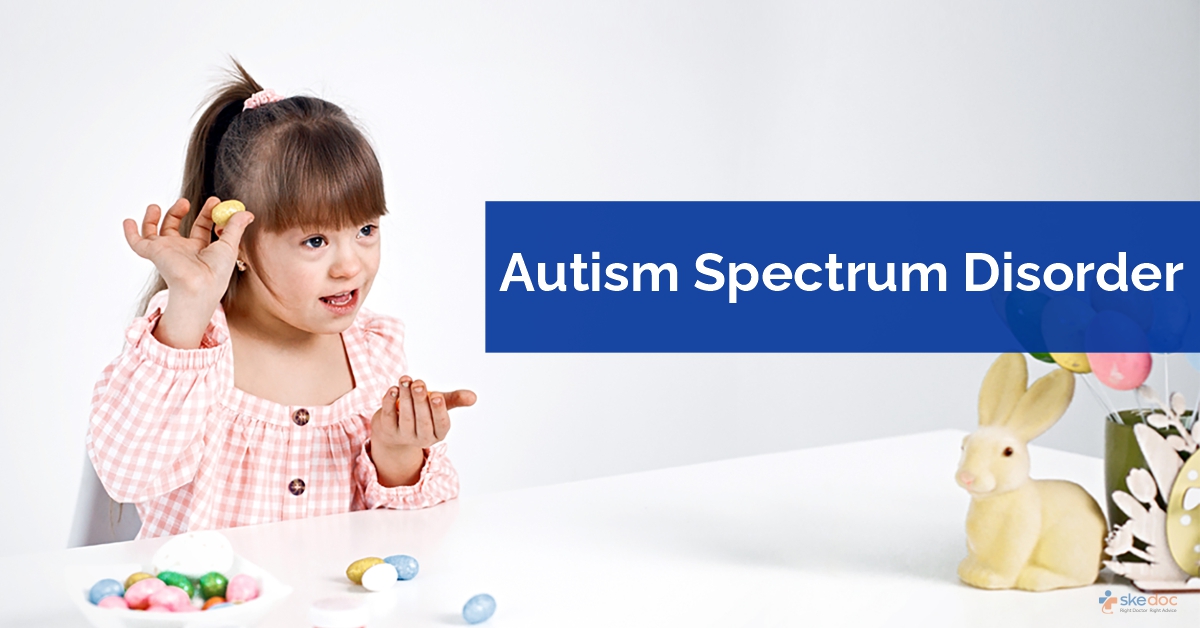Allergy
Blood Diseases
Bone & Joints
Brain
Cancer
Child Care
Cosmetic Surgery
Diabetes
Endocrinology
ENT
Eye
Gen Medicine
General Surgery
Heart
Kidney
Lifestyle
Liver & Digestive
Lung
Men’s Health
Mental health
Physiotherapy
Rheumatology
Skin and hair
Sleep Disorders
Spine
Transplant
Women Health
Thyroid
Vascular Surgery
Autism Spectrum Disorder: Types, Causes, Symptoms and Treatment

Overview
Autism spectrum disorder is a complex developmental and neurological condition that majorly affects people’s behavior towards their social communication skills, interaction with others, developmental delays, repetitive or restricted behavior, or lack of interest. Although autism can affect people of any age group, it is described as a “developmental disorder,” because symptoms often appear in the first two years of life. Children diagnosed with autism spectrum disorder often have different ways of learning, paying attention, or moving. Autism can be caused due to hereditary. According to research studies, genetics can contribute to about 10%-20% of the cases of autism.
Types of Autism Spectrum Disorder:
There are 5 main types of ASDs. They are listed below:
- Asperger’s syndrome- Asperger’s syndrome is a term that is no longer used in the medical field, it has been renamed as level 1 ASD by the DSM (Diagnostic and Statistical Manual of Mental Disorders)-5 diagnostic manual. Patients who are classified in this category will have above-average intelligence and will have good verbal skills but will encounter difficulty with social communication.
- Childhood Disintegrative Disorder (CDD)- CDD is also popularly known as Heller’s syndrome or disintegrative psychosis. It is a kind of neurodevelopmental disorder where children often have delayed onset of developmental problems in social function, language, and motor skills. The incidence of CDD is higher in male children compared to girl children.
- Pervasive Developmental Disorder (PDD)- It is one of the mild forms of ASD. The patients often find difficulty in language and social difficulty.
- Kanner’s syndrome- It is a classical autistic disorder. Patients often have difficulty in communication and interaction, lack of emotional attachment to others, uncontrollable speech, difficulty in remembering things, unable to recollect things.
- Rett syndrome- It is a very rare form of ASD, which is noticed mostly during the infant stage. The incidence is higher in girl children compared to boys. Children often complain of breathing difficulties, difficulty in speech and communication, and loss of standard coordination and movement.
Causes of Autism Spectrum Disorder:
The exact cause of ASD is not known. However, there are a few causes that play an important role in causing ASD. They include:
- Idiopathic cause (unknown cause)
- Environmental factors
- Genetics
- Obstetric complications
- Infections
Risk factors associated with Autism Spectrum Disorder:
The risk factors that are associated with ASD are listed below:
- Exposure to certain toxic substances during pregnancy
- Family history of ASD (hereditary)
- Parenteral age- females who are conceived at the age of ≥ 35 years.
- Obstetric complications
- Environmental factors that may contribute to the development of ASD
- Preterm children are at a higher risk of having ASD.
- ASD is associated with other disorders
Symptoms associated with Autism Spectrum Disorder:
The symptom of ASD varies from person to person. It depends on the type of ASD the person is suffering from, the age of the patient, and its severity. Symptoms that are associated with autism spectrum disorder are listed below:
Social communication and interaction- Children who are diagnosed with ASD will often find difficulty in communication skills and interacting with people. Symptoms include:
- Lack of facial expression and failure to interact with others
- Poor eye contact
- Fail to respond to his/her name
- Resists cuddling and holding people, does not prefer to play with other kids or elders
- Has difficulty in recognizing non-verbal cues, such as interpreting people’s facial expressions, tone of voice, and body postures.
- Does not understand or follow simple instructions or directions
- Delayed speech or does not speak
- They do not express their feelings or emotions or do not understand others’ emotions.
The pattern of behavior:
- They perform repetitive patterns of behavior such as hand flapping, spinning around, rocking, etc.
- Unusually sensitive to sound, light, touch
- Problem with coordination or has an odd walking pattern, such as walking on toes, stiff or exaggerated body movements, clumsiness, etc.
- Arranging things in a very particular manner.
- Specific food preferences
- Poor concentration
Diagnosis of Autism Spectrum Disorder:
Diagnosis of ASD in children is often a two-step procedure:
- Stage 1: General development screening during the child’s routine check-up
- Stage 2: Additional diagnostic evaluation- they include:
- Medical & neurological evaluation
- Assessment of child’s cognitive abilities
- Assessment of child’s language abilities
- Blood tests
- Neurological imaging- which includes CT or MRI of the brain, diffusion tensor imaging, SPECT (single photon emission tomography)
- Electroencephalography
- Polysomnography
- Genetic testing
Treatment for Autism Spectrum Disorder:
There is no cure for autism. The main aim of the treatment is to maximize the child’s ability to function normally by reducing the symptoms associated with autism spectrum disorder and supporting learning and developmental skills. Recognizing the condition early will result in an overall good outcome for the children and adults. There are various methods available to treat autism; the treatment plans include:
- Behavioural and communication therapy- During this treatment, they help to treat social, language, and behavioral difficulties that are associated with autism. This therapy also emphasizes teaching new skills, how to communicate better with people, and how to act in social situations.
- Developmental approaches- The main aim of this therapy is to improve specific developmental skills, which include language skills, physical skills, and a broad range of interconnected developmental abilities. The most used developmental approach that is used to treat ASD is speech and language therapy, which helps in improving the person’s ability to understand and use speech and language in order to communicate with others.
- Educational therapy- Children who are diagnosed with ASD often respond well to highly structured educational programs. During this therapy, the therapist will use a wide range of activities that focus mainly on improving the social skills, communication skills, and behavior of the children.
- Social-relational approaches- This therapy, often focuses on improving social skills and helps in building an emotional bond with the people.
- Psychological approaches- these therapies will help people to cope with depression, anxiety, and other mental health disorders. One of the best psychological therapies is cognitive-behavior therapy (CBT). It will help the patient to focus on learning the connection between feelings, thoughts, and behaviors.
- Family therapy- during this therapy, the parents and other family members can learn how to play and interact with their child in order to promote social interaction skills, teach how to communicate with others, manage their behavioral problems, and teach daily living skills.
- Complementary and other alternative therapy- Including chiropractic care, animal therapy, herbal supplements, special diet, relaxation therapies, mindful games, and art therapy.
- Medications if required to treat conditions that are associated with ASD.
References
- Autism Spectrum Disorder "National Institute of Mental Health (NIMH)"
- What Are the 5 Different Types of Autism? "MedicineNet"
- Autism spectrum disorder "mobile physiotherapy clinic"
- Autism spectrum disorder "mayo clinic"
- Treatment and Intervention Services for Autism Spectrum Disorder "Centers for Disease Control and Prevention"
- Autism Spectrum Disorder Workup "Medscape"
Was this article helpful?
YesNo




